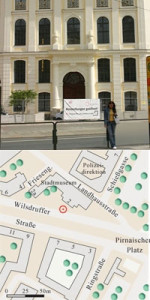 After 13 February 1945, the late-baroque, classical country house was in ruins, as were hundreds of other architectural monuments in the Dresden city centre. Only the surrounding wall of the great staircase remained with its empty windows facing the former forecourt. In 1957 the house’s magnificent portal, which had remained largely undamaged, stood in the way of the plans to expand Wilsdruffer Straße into a main traffic artery and processional route for large-scale demonstrations and it was therefore removed to Park Großsedlitz. The reconstruction of the country house for use as a city museum began six years later. The ruins of the valuable historic buildings in the surrounding streets had long since been abandoned, torn down and removed.
After 13 February 1945, the late-baroque, classical country house was in ruins, as were hundreds of other architectural monuments in the Dresden city centre. Only the surrounding wall of the great staircase remained with its empty windows facing the former forecourt. In 1957 the house’s magnificent portal, which had remained largely undamaged, stood in the way of the plans to expand Wilsdruffer Straße into a main traffic artery and processional route for large-scale demonstrations and it was therefore removed to Park Großsedlitz. The reconstruction of the country house for use as a city museum began six years later. The ruins of the valuable historic buildings in the surrounding streets had long since been abandoned, torn down and removed.
Such reclamations, losses and removals proved typical of the reconstruction of Dresden’s city centre. The clearing of the fifteen square-kilometre ruined area and its slow-paced reconstruction were dictated by the practical necessities of the difficult post-war era and guided by the vision of a “New Dresden” – a vision that stemmed equally from the modern urban-planning convictions of the day and the social dogmas of the political bureaucracy. As a result, most of the remains of the historical city centre disappeared in the large-scale process of rubble clearance. Some two dozen of the most valuable architectural monuments were spared demolition and reconstructed using the available economic resources.
Dresdeners passionately followed these developments and measured the results of the reconstruction against the ideal “Old Dresden” of their memories. In February 1945, most of the places which had symbolised the city’s identity were lost forever. Thus, the stubborn endeavours to win back a lost cityscape are an attempt to overcome the catastrophic loss of identity resulting from Dresden’s destruction.
Marked in 2007.
